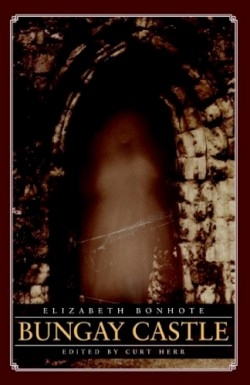Bungay Castle
“In the middle of a cold and inclement winter’s night, when the wind blew with uncontrollable force, and the snow, rain, and hail beat with fury against the windows … came a loud rapping at the western gate.” Thus begins this mystery, splendidly woven into the tapestry of a colorful Gothic tale and a time of lords, ladies, and filthy rich barons searching for innocent maidens.
The story is 200 years old, a feminine Gothic novel by a writer ahead of her time for reversing gender stereotypes: her damsels save young men from doom and virginal daughters rebel against patriarchal commands. Bonhote (1744—1818) wrote four novels, and verse that appeared in provincial newspapers. The twelfth-century Bungay Castle is a real place, purchased by the author’s husband at her request. The romantic ruin and its fabled history inspired Eliza’s last novel, which established her as a best-selling author in 1796.
The DeMornays occupy the castle with children, soldiers, social acquaintances, and domestic help. An old friend of Sir Philip DeMornay, “the notable, middle-aged and hefty Baron Fitzobourne” arrives for an arranged marriage to Sir Philip’s daughter, Roseline, meant to reduce her father’s debts.
True to Gothic form, Bungay Castle has turrets spiraling toward the sky, hidden dungeons, and escape tunnels where ghosts are seen slithering in the night. When a thunderstorm echoes one night between dark, dank castle walls, unexplained sounds come from below. Three teenage characters, Roseline, her brother Edwin, and their friend Madeline (sent to a nunnery by her family but recuperating from an illness at the castle) venture down the hidden staircase. Passing an old wooden coffin, “which appeared to have stood there for ages with its silent inhabitant falling to decay,” torture chambers, and human bones, they enter a hidden room to find a prisoner who will change their fate.
As preparations are made for her impending marriage to the loathsome Baron, Roseline becomes despondent “by a thought so unnatural, so repugnant to every wish, every feeling of her heart,—so inimical to the ideas she had formed of happiness … that it would make her the veriest wretch on earth.”
As in all Gothic novels, romance plays havoc with Edwin and Madeline, and they are swept into the throes of love: “Thus was the little god, who has been a delight and torment of all ages … aiming his arrows at hearts too innocent to guard against or repel their attacks.”
The editor of this re-release teaches drama, British literature, and Gothic literature at Kutztown University. The story, with festive balls, secret lovers, ghostly hauntings, arranged lives, and marriages is held tightly by the thread of the female Gothic theme. Suspense permeates every page until the typically climactic outcome. As Bonhote narrates, she offers asides of fine details and descriptions. A sense of place and time adds appeal to the story, ghosts and all.
Disclosure: This article is not an endorsement, but a review. The publisher of this book provided free copies of the book to have their book reviewed by a professional reviewer. No fee was paid by the publisher for this review. Foreword Reviews only recommends books that we love. Foreword Magazine, Inc. is disclosing this in accordance with the Federal Trade Commission’s 16 CFR, Part 255.

